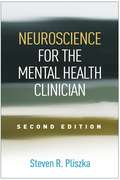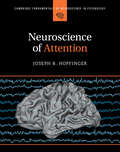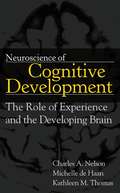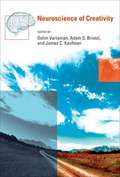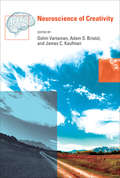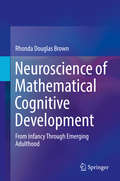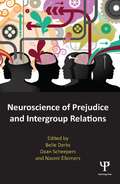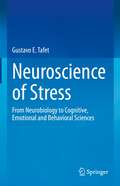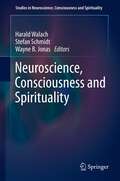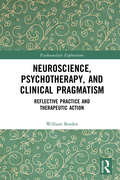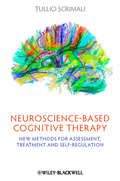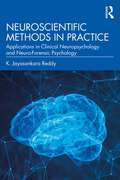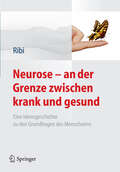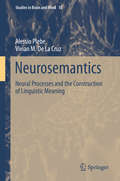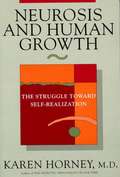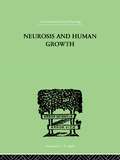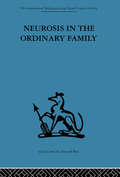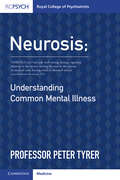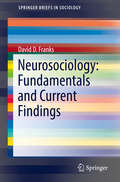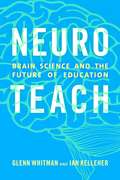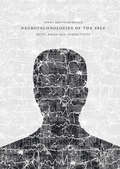- Table View
- List View
Neuroscience for the Mental Health Clinician, Second Edition
by Steven R. PliszkaAccessible and succinct, this book has given thousands of clinicians and students the basic understanding of neuroscience that is essential in contemporary mental health practice. Steven R. Pliszka synthesizes current knowledge on the neurobiological bases of major psychiatric disorders. He explores the brain systems that underlie cognition, emotions, and behavior; how disturbances in these systems can lead to psychopathology; and the impact of genetic and environmental risk factors across development. The book also addresses the ways that both pharmacological and psychosocial treatments act on the brain as they bring about a reduction in symptoms. Illustrations include 93 black-and-white figures and 14 color plates. New to This Edition *Incorporates over a decade of important advances in brain science. *Heightened focus on brain networks replaces a deficit-based understanding of disorders. *Cutting-edge discussions of genetics and epigenetics, the biological impact of stress, neurotransmitters, novel depression treatments, and other timely topics. *Detailed chapters on autism spectrum disorder and dementia. *Numerous new and revised figures.
Neuroscience of Attention (Cambridge Fundamentals of Neuroscience in Psychology)
by Joseph B. HopfingerAttention is critical to our daily lives, from simple acts of reading or listening to a conversation to the more demanding situations of trying to concentrate in a noisy environment or driving on a busy roadway. This book offers a concise introduction to the science of attention, featuring real-world examples and fascinating studies of clinical disorders and brain injuries. It introduces cognitive neuroscience methods and covers the different types and core processes of attention. The links between attention, perception, and action are explained, along with exciting new insights into the brain mechanisms of attention revealed by cutting-edge research. Learning tools – including an extensive glossary, chapter reviews, and suggestions for further reading – highlight key points and provide a scaffolding for use in courses. This book is ideally suited for graduate or advanced undergraduate students as well as for anyone interested in the role attention plays in our lives.
Neuroscience of Cognitive Development
by Charles A. Nelson Kathleen M. Thomas Michelle De HaanA new understanding of cognitive development from the perspective of neuroscienceThis book provides a state-of-the-art understanding of the neural bases of cognitive development. Although the field of developmental cognitive neuroscience is still in its infancy, the authors effectively demonstrate that our understanding of cognitive development is and will be vastly improved as the mechanisms underlying development are elucidated.The authors begin by establishing the value of considering neuroscience in order to understand child development and then provide an overview of brain development. They include a critical discussion of experience-dependent changes in the brain. The authors explore whether the mechanisms underlying developmental plasticity differ from those underlying adult plasticity, and more fundamentally, what distinguishes plasticity from development.Having armed the reader with key neuroscience basics, the book begins its examination of the neural bases of cognitive development by examining the methods employed by professionals in developmental cognitive neuroscience. Following a brief historical overview, the authors discuss behavioral, anatomic, metabolic, and electrophysiological methods. Finally, the book explores specific content areas, focusing on those areas where there is a significant body of knowledge on the neural underpinnings of cognitive development, including:* Declarative and non-declarative memory and learning* Spatial cognition* Object recognition* Social cognition* Speech and language development* Attention developmentFor cognitive and developmental psychologists, as well as students in developmental psychology, neuroscience, and cognitive development, the authors' view of behavioral development from the perspective of neuroscience sheds new light on the mechanisms that underlie how the brain functions and how a child learns and behaves.
Neuroscience of Creativity
by James C. Kaufman Oshin Vartanian Adam S. BristolThis volume offers a comprehensive overview of the latest neuroscientific approaches to the scientific study of creativity. In chapters that progress logically from neurobiological fundamentals to systems neuroscience and neuroimaging, leading scholars describe the latest theoretical, genetic, structural, clinical, functional, and applied research on the neural bases of creativity. The treatment is both broad and in depth, offering a range of neuroscientific perspectives with detailed coverage by experts in each area. Following opening chapters that offer theoretical context, the contributors discuss such issues as the heritability of creativity; creativity in patients with brain damage, neurodegenerative conditions, and mental illness; clinical interventions and the relationship between psychopathology and creativity; neuroimaging studies of intelligence and creativity; neuroscientific basis of creativity-enhancing methodologies; and the information-processing challenges of viewing visual art. ContributorsBaptiste Barbot, Mathias Benedek, David Q. Beversdorf, Aaron P. Blaisdell, Margaret A. Boden, Dorret I. Boomsma, Adam S. Bristol, Shelley Carson, M. H. M. de Moor, Andreas Fink, Liane Gabora, Dennis Garlick, Elena L. Grigorenko, Richard J. Haier, Rex E. Jung, James C. Kaufman, Helmut Leder, Kenneth J. Leising, Bruce L. Miller, Apara Ranjan, M. P. Roeling, W. David Stahlman, Mei Tan, Pablo P. L. Tinio, Oshin Vartanian, Indre V. Viskontas, Dahlia W. Zaidel
Neuroscience of Creativity (The\mit Press Ser.)
by James C. Kaufman Oshin Vartanian Adam S. BristolExperts describe current perspectives and experimental approaches to understanding the neural bases of creativity. This volume offers a comprehensive overview of the latest neuroscientific approaches to the scientific study of creativity. In chapters that progress logically from neurobiological fundamentals to systems neuroscience and neuroimaging, leading scholars describe the latest theoretical, genetic, structural, clinical, functional, and applied research on the neural bases of creativity. The treatment is both broad and in depth, offering a range of neuroscientific perspectives with detailed coverage by experts in each area. The contributors discuss such issues as the heritability of creativity; creativity in patients with brain damage, neurodegenerative conditions, and mental illness; clinical interventions and the relationship between psychopathology and creativity; neuroimaging studies of intelligence and creativity; the neuroscientific basis of creativity-enhancing methodologies; and the information-processing challenges of viewing visual art.ContributorsBaptiste Barbot, Mathias Benedek, David Q. Beversdorf, Aaron P. Blaisdell, Margaret A. Boden, Dorret I. Boomsma, Adam S. Bristol, Shelley Carson, Marleen H. M. de Moor, Andreas Fink, Liane Gabora, Dennis Garlick, Elena L. Grigorenko, Richard J. Haier, Rex E. Jung, James C. Kaufman, Helmut Leder, Kenneth J. Leising, Bruce L. Miller, Apara Ranjan, Mark P. Roeling, W. David Stahlman, Mei Tan, Pablo P. L. Tinio, Oshin Vartanian, Indre V. Viskontas, Dahlia W. Zaidel
Neuroscience of Decision Making (Contemporary Topics in Cognitive Neuroscience)
by Oshin Vartanian David R. MandelThe intersection between the fields of behavioral decision research and neuroscience has proved to be fertile ground for interdisciplinary research. Whereas the former is rich in formalized models of choice, the latter is rife with techniques for testing behavioral models at the brain level. As a result, there has been the rapid emergence of progressively more sophisticated biological models of choice, geared toward the development of ever more complete mechanistic models of behavior. This volume provides a coherent framework for distilling some of the key themes that have emerged as a function of this research program, and highlights what we have learned about judgment and decision making as a result. Although topics that are theoretically relevant to judgment and decision making researchers are addressed, the book also ventures somewhat beyond the traditional boundaries of this area to tackle themes that would of interest to a greater community of scholars. Neuroscience of Decision Making provides contemporary and essential reading for researchers and students of cognitive psychology, neuroscience, philosophy, and economics.
Neuroscience of Mathematical Cognitive Development: From Infancy Through Emerging Adulthood
by Rhonda Douglas BrownThis book examines the neuroscience of mathematical cognitive development from infancy into emerging adulthood, addressing both biological and environmental influences on brain development and plasticity. It begins by presenting major theoretical frameworks for designing and interpreting neuroscience studies of mathematical cognitive development, including developmental evolutionary theory, developmental systems approaches, and the triple-code model of numerical processing. The book includes chapters that discuss findings from studies using neuroscience research methods to examine numerical and visuospatial cognition, calculation, and mathematical difficulties and exceptionalities. It concludes with a review of mathematical intervention programs and recommendations for future neuroscience research on mathematical cognitive development.Featured neuroscience research methods include:Functional Magnetic Resonance Imaging (fMRI). Diffusion Tensor Imaging (DTI).Event Related Potentials (ERP).Transcranial Magnetic Stimulation (TMS).Neuroscience of Mathematical Cognitive Development is an essential resource for researchers, clinicians and related professionals, and graduate students in child and school psychology, neuroscience, educational psychology, neuropsychology, and mathematics education.
Neuroscience of Prejudice and Intergroup Relations
by Naomi Ellemers Belle Derks Daan ScheepersPsychological research on the origins and consequences of prejudice, discrimination, and stereotyping has moved into previously uncharted directions through the introduction of neuroscientific measures. Psychologists can now address issues that are difficult to examine with traditional methodologies and monitor motivational and emotional as they develop during ongoing intergroup interactions, thus enabling the empirical investigation of the fundamental biological bases of prejudice. However, several very promising strands of research have largely developed independently of each other. By bringing together the work of leading prejudice researchers from across the world who have begun to study this field with different neuroscientific tools, this volume provides the first integrated view on the specific drawbacks and benefits of each type of measure, illuminates how standard paradigms in research on prejudice and intergroup relations can be adapted for the use of neuroscientific methods, and illustrates how different methodologies can complement each other and be combined to advance current insights into the nature of prejudice. This cutting-edge volume will be of interest to advanced undergraduates, graduates, and researchers students who study prejudice, intergroup relations, and social neuroscience.
Neuroscience of Stress: From Neurobiology to Cognitive, Emotional and Behavioral Sciences
by Gustavo E. TafetThis textbook provides an introduction to the interdisciplinary study of stress, helping students and professionals understand the main neurobiological and psychological causes and consequences of stress in human beings. It’s aimed at understanding the concept of stress at different levels, from the impact of environmental stressors to its processing in the brain, and from the neural mechanisms involved in this processing to the expression of different adaptive responses. All these neural mechanisms are clearly explained according to different levels of complexity, from the neurobiological level, including the cellular and molecular mechanisms, to the psychological level, including the cognitive and emotional processing, and behavioral expressions.The whole content is described in a very comprehensive manner, accompanied with descriptive graphics to clearly illustrate every detail, therefore allowing a full integration of all the covered concepts. In addition, clinical expressions of stress, such as mood and anxiety disorders, are also covered in detail, including an overview of different factors of vulnerability and resilience, therefore providing a unique and fundamental insight of this interdisciplinary field. Given its interdisciplinary approach, Neuroscience of Stress: From Neurobiology to Cognitive, Emotional and Behavioral Sciences will provide a comprehensive and clear introduction to the study of stress to students and professionals from different fields of the behavioral and health sciences. It will serve as a valuable text for adoption in classes of a wide range of graduate courses dealing with mental health and well-being, in areas such as health and clinical psychology, health promotion and disease prevention, psychiatry and behavioral medicine, among others.
Neuroscience, Consciousness and Spirituality
by Wayne B. Jonas Harald Walach Stefan SchmidtNeuroscience, Consciousness and Spirituality presents a variety of perspectives by leading thinkers on contemporary research into the brain, the mind and the spirit. This volumes aims at combining knowledge from neuroscience with approaches from the experiential perspective of the first person singular in order to arrive at an integrated understanding of consciousness. Individual chapters discuss new areas of research, such as near death studies and neuroscience research into spiritual experiences, and report on significant new theoretical advances. From Harald Walach's introductory essay, "Neuroscience, Consciousness, Spirituality - Questions, Problems and Potential Solutions," to the concluding chapter by Robert K. C. Foreman entitled "An Emerging New Model for Consciousness: The Consciousness Field Model," this book represents a milestone in the progress towards an integrated understanding of spirituality, neuroscience and consciousness. It is the first in a series of books that are dedicated to this topic.
Neuroscience, Neurophilosophy and Pragmatism
by John R. Shook Tibor SolymosiBringing together active neuroscientists, neurophilosophers, and scholars this volume considers the prospects of a neuroscientifically-informed pragmatism and a pragmatically-informed neuroscience on issues ranging from the nature of mental life to the implications of neuroscience for education and ethics.
Neuroscience, Psychotherapy and Clinical Pragmatism: Reflective Practice and Therapeutic Action (Psychoanalytic Explorations)
by William BordenThis volume explores how the principles and values of pragmatic philosophy serve as orienting perspectives for critical thinking in contemporary psychotherapy and clinical practice. Drawing on the contributions of William James and John Dewey, Neuroscience, Psychotherapy, and Clinical Pragmatism introduces a model of clinical pragmatism emphasizing the individuality of the person, open-ended dialogue, experiential learning, and the practical outcomes of ideas and methods. In a second part, chapters show how recent developments in neuroscience and interpersonal neurobiology deepen our understanding of change and growth in accord with the principles of clinical pragmatism. Finally, the volume reviews paradigms of psychotherapy across the psychodynamic, behavioral, cognitive, and humanistic traditions. Case studies show how the pluralist orientation of clinical pragmatism enlarges concepts of therapeutic action. This text has been written for psychotherapists as well as scholars, educators, and trainees in the fields of psychiatry, clinical psychology, counseling, and social work.
Neuroscience-based Cognitive Therapy
by Tullio ScrimaliA pioneer of CBT explores recent advances in neuroscience, showing how they can be applied in practice to improve the effectiveness of cognitive therapy for clients with a wide range of diagnoses including mood disorders, anxiety disorders, eating disorders and schizophrenia Utilizes the latest advances in neuroscience to introduce tools that allow clinicians, for the first time, to directly 'measure' the effectiveness of cognitive therapy interventions Rigorously based in neuroscientific research, yet designed to be readable and jargon-free for a professional market of CBT practitioners Covers theory, assessment, and the treatment of a wide range of specific disorders including anxiety disorders, mood disorders, eating disorders, addictions and schizophrenia Written by a respected pioneer in the field
Neuroscience: Psychoanalytic Inquiry, 12.3
by Andrew SchwartzFirst published in 1992. Routledge is an imprint of Taylor & Francis, an informa company.
Neuroscientific Methods in Practice: Applications in Clinical Neuropsychology and Neuro-Forensic Psychology
by K. Jayasankara ReddyThis book presents an in-depth exploration of the convergence of neuroscience with clinical psychology, clinical neuropsychology, and forensic psychology, examining advanced methodologies, practical applications, and real-world case studies.K. Jayasankara Reddy provides a thorough examination of state-of-the-art neuroscientific methods and the revolutionary effects on both diagnosis and forensic inquiry. Reddy highlights the transformative impact of neuroimaging, neurophysiology, neuroelectrophysiology, and genetic analysis on our comprehension of brain function and behavior, using compelling case examples and empirical evidence. This book not only discusses methods but also critically examines ethical difficulties, merits, and challenges of the techniques, as well as the legal ramifications that may arise from the use of neuroscientific evidence in clinical and forensic settings. This book also highlights the need for a sophisticated comprehension of privacy issues, patient self-governance, and the use of neurobiological information within legal structures.Overall, it provides readers with the tools to negotiate complicated ethical landscapes while responsibly utilizing neuroscientific discoveries, advocating for a balanced approach that combines scientific rigor and ethical responsibility. This volume is an important resource for students, researchers, and practitioners of clinical neuropsychology, forensic psychology, and neuroscience.
Neurose - an der Grenze zwischen krank und gesund
by Alfred RibiNeurotische Störungen sind sehr verbreitet. Freud sagte sogar: "Jedermann ist etwas neurotisch." Man kann natürlich etwas, was in der Bevölkerung dermaßen verbreitet ist, nicht als krankhaft, d.h. als Abweichung von der Norm bezeichnen. Kann man es deshalb aber von "Gesundsein" abgrenzen? So wenig wie eine Frau ein bisschen schwanger sein kann, so wenig kann einer ein bisschen neurotisch sein. Die Jung'sche Auffassung von der Neurose hilft, diagnostisch Klarheit zu schaffen. Dieses Buch ist zunächst ein Buch für Fachleute, es ist aber auch ein "Aufklärungsbuch" für interessierte Laien, das die veralteten Vorurteile über das Wesen der Neurose abbauen hilft. Geschrieben für Psychologen und Psychiater, Absolventen einer Jung'schen Ausbildung, interessierte Laien.
Neurosemantics
by Alessio Plebe Vivian M. De La CruzThis book examines the concept of " Neurosemantics", a term currently used in two different senses: the informational meaning of the physical processes in the neural circuits, and semantics in its classical sense, as the meaning of language, explained in terms of neural processes. The book explores this second sense of neurosemantics, yet in doing so, it addresses much of the first meaning as well. Divided into two parts, the book starts with a description and analysis of the mathematics of the brain, including computational units, representational mechanisms and algorithmic principles. This first part pays special attention to the neural architecture which has been used in developing models of neurosemantics. The second part of the book presents a collection of models, and describes each model reproducing specific aspects of the semantics of language. Some of these models target one of the core problems of semantics, the reference of nouns, and in particular of nouns with a strong perceptual characterization. Others address the semantics of predicates, with a detailed analysis of colour attributes. While this book represents a radical shift from traditional semantics, it still pursues a line of continuity that is based on the idea that meaning can be captured, and explained, by a sort of computation.
Neurosis and Human Growth: The Struggle Toward Self-Realization
by Karen HorneyDr. Horney discusses the neurotic process as a special form of the human development, the antithesis of healthy growth. She unfolds the different stages of this situation, describing neurotic claims, the tyranny or inner dictates and the neurotic's solutions for relieving the tensions of conflict in such emotional attitudes as domination, self-effacement, dependency, or resignation.
Neurosis and Human Growth: The struggle toward self-realization (International Library Of Psychology Ser.)
by Karen HorneyIn Neurosis and Human Growth, Dr. Horney discusses the neurotic process as a special form of the human development, the antithesis of healthy growth. She unfolds the different stages of this situation, describing neurotic claims, the tyranny or inner dictates and the neurotic's solutions for relieving the tensions of conflict in such emotional attitudes as domination, self-effacement, dependency, or resignation. Throughout, she outlines with penetrating insight the forces that work for and against the person's realization of his or her potentialities. First Published in 1950. Routledge is an imprint of Taylor & Francis, an informa company.
Neurosis in the Ordinary Family: A psychiatric survey
by Anthony RyleTavistock Press was established as a co-operative venture between the Tavistock Institute and Routledge & Kegan Paul (RKP) in the 1950s to produce a series of major contributions across the social sciences. This volume is part of a 2001 reissue of a selection of those important works which have since gone out of print, or are difficult to locate. Published by Routledge, 112 volumes in total are being brought together under the name The International Behavioural and Social Sciences Library: Classics from the Tavistock Press. Reproduced here in facsimile, this volume was originally published in 1967 and is available individually. The collection is also available in a number of themed mini-sets of between 5 and 13 volumes, or as a complete collection.
Neurosis: The Logic of a Metaphysical Illness
by Wolfgang GiegerichPsychoanalysis began over a century ago as a treatment for neurosis. Rooted in the positivistic mindset of the medicine from which it stemmed, it trained its empiricist gaze directly upon the symptoms of the malaise, only to be seduced into attributing it to causes as numerous as there are aspects of human experience. Edifying as this was for our understanding of the life of the psyche, it left the sickness of the soul that was its actual subject matter, the neurosis which it was supposed to be about, out of its purview. The crux of this problem was of a conceptual nature. As psychology increasingly gave up on its constituting concept, its concept of soul, it succumbed to the same extent to treating its patients without an adequate concept of what both it and neurosis were about. Attention was paid to mishaps and traumas, the vicissitudes of development, and the Oedipus complex. But neurosis, according to the thesis of this ground-breaking book, comes from the soul, even is soul; the soul in its untruth. Indeed, both it and the modern field of psychology are successors of the soul-forms that preceded them, religion and metaphysics, with the difference that psychology's reluctance to recognize and take responsibility for its status as such has been matched by the neurotic soul's clinging to obsolete metaphysical categories even as the often quite ordinary life disappointments of its patients are inflated with absolute importance. The folie à deux has been on a massive scale. Owing their provenance to the supplement they each provide the other, psychology and neurosis are entwined in a Gordian knot, the cutting of which requires insight into the logic that pervades both. Taking up this sword, Giegerich exposes and critiques the metaphysics that neurosis indulges in even as he returns psychology to the soul, not, of course, to the soul as some no longer credible metaphysical hypostasis, but as the logically negative life of the mind and power of thought. Using several fairy tales as models for the logic of neurosis, he brilliantly analyses its enchanting background processes, exposing thereby, in a most lively and thoroughgoing manner, the spiteful cunning by which the neurotic soul, against its already existing better judgement, betrays its own truth. Topics include the historicity of neurosis, its soulful purpose as a general cultural phenomenon, its internal logic, functioning, and enabling conditions, as well as the Sacred Festival drama character of symptomatic suffering, the theology of neurosis, and ‘the neurotic’ as the figure of modernity's exemplary man. A collection of vignettes descriptive of various kinds of neurotic presentation routinely met with in the consulting room is also included in an appendix under the heading, ‘Neurotic Traps.’
Neurosis: Understanding Common Mental Illness
by Peter TyrerCommon mental illnesses have been diagnosed separately in recent years, but what is seldom understood is that they are all linked together, often much more closely than other disorders. In particular, combined anxiety and depression linked to personality disturbance, generally known as neuroticism, is very common. In the absence of awareness of its importance, this frequently leads to wrong clinical decisions and poor outcomes for patients. This book focuses on the concept of neurosis, tracing its history as a concept, its abolition from the DSM, the purpose and importance of the Nottingham Study of Neurotic Disorder, the re-definition of neurosis as the general neurotic syndrome, and its recently updated evidence base. Written for psychiatrists, psychologists and researchers, this book shows how recognising these combined common disorders is absolutely necessary for mental health practice, and urges that it is time that we re-examine our treatment priorities.
Neurosociology: Fundamentals and Current Findings (SpringerBriefs in Sociology)
by David D. FranksThis book offers an introduction to the fundamentals of neurosociology and presents the newest issues and findings in the field. It describes the evolution of the brain and its social nature. It examines the concept of knowing and what can be known, as well as the subjective sensations we experience. Next, it explores the ubiquitousness of New Unconsciousness and the latest conclusions about mirror neurons. Additional themes and concepts described are sex differences in the brain, imitation, determinism and agency.The book brings together neuroscience and sociology, two fields that are very different in terms of method, theory, tradition and practice. It does so building on the following premise: If our brains have been forged evolutionarily over the many centuries for social life, sociologists should have the opportunity, if not the duty, to know about it whatever the reservations of some who think that any approach that includes biology must be reductionistic.
Neuroteach: Brain Science and the Future of Education
by Glenn Whitman and Ian KelleherNeuroteach was therefore written to help solve the problem teachers and school leaders have in knowing how to bring the growing body of educational neuroscience research into the design of their schools, classrooms, and work with each individual student.
Neurotechnologies of the Self
by Jonna BrenninkmeijerTaking care of oneself is increasingly interpreted as taking care of one's brain. Apart from pills, books, food, and games for a better brain, people can also use neurotechnologies for self-improvement. This book explores how the use of brain devices to understand or improve the self changes people's subjectivity. This book describes how the effects of several brain devices were and are demonstrated; how brains and selves interact in the work of early brainwave scientists and contemporary practitioners; how users of neurofeedback (brainwave training) constitute a new mode of self that is extended with a brain and various other (physiological, psychological, material, and sometimes spiritual) entities, ∧ how clients, practitioners and other actors (computers, brain maps, brainwaves) perform a dance of agency during the neurofeedback process. Through these topics, Jonna Brenninkmeijer provides a historical, ethnographical, and theoretical exploration of the mode of being that is constituted when people use a brain device to improve themselves.
